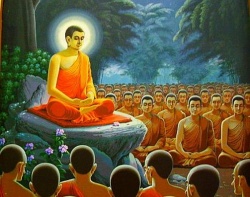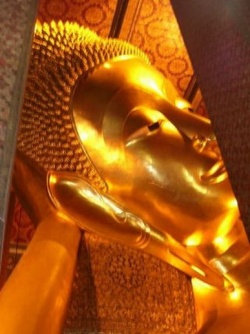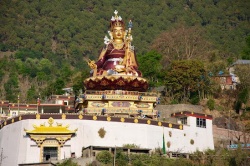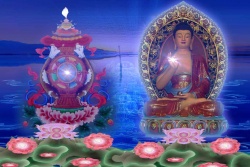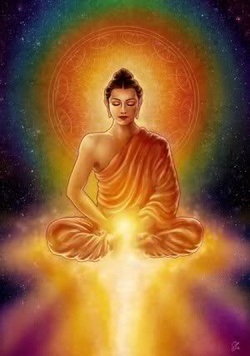The Third Tongkhor, Gyelwa Gyatso
Gyelwa Gyatso (rgyal ba rgya mtsho) was in born in 1588, the earth-mouse year of the tenth sexagenarian cycle, in Trisho Takzang (tri shod stag bzang), which is also called Kardzin (skar 'dzin). His father was Sonam Gyel (bsod nams rgyal) and his mother was named Pema Tso (pad+ma mtsho).
When he was three months old he was recognized as the reincarnation of the Second Tongkhor, Yonten Gyatso (stong 'khor 02 yon tan rgya mtsho, 1556-1587), by Lobzang Tenpa Gyeltsen (blo bzang bstan pa rgyal mtshan, d.u.), the reincarnation of Dakpo Choje Zhonnu Dorje (dwags po chos rje gzhon nu rdo rje, 1550-1575; these dates are likely off by sixty years). He was put to tests and affirmed at the age of eight months by the local Mongolian aristocracy under the command of Nangso Sonam Gyeltsen (nang so bsod nams rgyal mtshan, d.u), the son of Nangso Rinchen Lhunpo (nang so rin chen lhun po, d.u.). (The title Nangso belonged to lay officials in charge of the biennial missions to Beijing.) He was then brought to Tongkhor Tashilhunpo, which the First Tongkhor Dawa Gyeltsen (stong 'khor 01 zla ba rgyal mtshan, 1476-1556) had established in the mid-sixteenth century.
There, at the age of four, he received upāsaka vows and teachings from Lobzang Tenpai Gyatso (blo bzang bstan pa'i rgya mtsho, d.u) and the name Gyelwa Gyatso Pel Zangpo (rgyal ba rgya mtsho dpal bzang po). The next year he received novice vows from the same lama.
At the age of seven he went to Tsokhar Kholo Chi (mtsho khar kho lo chi) and met with the local leader named Lochi ([[lo [chi]]), a member of the same family as Altan Khan (1507-1582), the patron of the Third Dalai Lama, Sonam Gyatso (ta la'i bla ma 03 bsod nams rgya mtsho, 1543-1588). As he grew older other local leaders invited him to teach as well: Shedrak (she grags), the local leader of Purtse (phur tshe); Bumkhyab Yak ('bum skyabs yag)), the local leader of Welshul (dbal shul); and Akyong (a skyong), the local leader of Golok (mgo log). He received teachings at monasteries such as Kirti, Daktsang (dwag tshang), Muge (dmu dge), and Zungchu (zung chu).
He received full ordination from Kyisho Choje (skyid shod chos rje, d.u.), together with a Vajramāla empowerment.
At some point he went to Oro (o rod) and mediated a dispute between Chinese and Mongolian communities.
Gyelwa Gyatso went to U-Tsang where he met with the Fourth Dalai Lama, Yonten Gyatso (ta la'i bla ma yon tan rgya mtsho, 1589-1616) and the Fourth Panchen Lama, Lobzang Chokyi Gyeltsen (blo bzang chos kyi rgyal mtshan, 1570-1609) and received from them teachings and empowerments.
On his return to Kham he repaired Tashilhunpo, which had suffered damage from an earthquake.
Gyelwa Gyatso passed away at the age of fifty-two in 1639, in Atsa Mokhor (a tsha mo khor) in Shudru (shu gru). According to tradition, at death he transferred his consciousness, using the Tibetan phenomenon known as powa drongjuk ('pho ba grong 'jug), into the corpse of a recently-deceased seventeen year old half-Chinese boy, who sat up and declared himself to be the Tongkhor Lama. The boy gained support and went on to be the Fourth Tongkhor, Dogyu Gyatso, (mdo rgyud rgya mtsho, d.1683).
Sources
Anon. 2005 (1930). Stong 'khor zla ba rgyal mtshan sku phreng rim byon gyi rnam thar. Bejing: Krung go'i bod rig pa dpe skrun khang, pp. 167-192. TBRC W2CZ7868.
Bsod nams rgya mtsho. 2000. Bstan rtsis ka phreng lag deb. Beijing: Mi rigs dpe skrun khang, p. 235. TBRC W20115.
Dung dkar blo bzang 'phrin las. 2002. Dung dkar tshig mdzod chen mo. Beijing: Krung go'i bod rig pa dpe skrun khang, p. 2327. TBRC W26372.
Grags pa 'byung gnas and Rgyal ba blo bzang mkhas grub. 1992. Gangs can mkhas grub rim byon ming mdzod. Lanzhou: Kan su'u mi rigs dpe skrun khang, pp. 769-770. TBRC W19801.
Sørensen, Per. 2007. "Restless relic – The Ārya Lokeśvara icon in Tibet: Symbol of power, legitimacy and pawn for patronage." In Kellner, Birgit, et. al., eds., Pramāṇakīrtiḥ. Papers dedicated to Ernst Steinkellner on the occasion of his 70th birthday, vol. 2, pp. 857ff, Vienna: Institut für Südasien-, Tibet- und Buddhismuskunde, pp. 876-877.
Sonam Dorje September 2012
